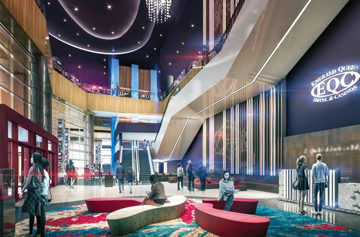
In 1977, Seminole Chief Howard Tommie traveled from Florida to Pittsburgh to learn how churches and VFWs used bingo to raise extra money.
Two years later, when the Seminoles introduced the nation’s first high-stakes tribal bingo hall, they kicked off a multibillion-dollar nationwide and global industry that, 40 years on, continues to grow in power and influence. In many cases, tribes that once operated out of roadside trailers and tents are building resorts as big and blingy as anything in Vegas.
Case in point: In March 2018, Pechanga Resort & Casino completed a $300 million expansion that made it the largest Native American resort in Southern California. The Pechanga Band of Luiseño Indians added a new 14-story AAA four-diamond hotel tower, 67,000 square feet of event space, a lavish two-story spa, and a 4.5-acre pool complex. Design-wise, nods to tribal culture are implied but not overt; the history of the band is related in dedicated displays of tribal artifacts and pottery in the casino and hotel, and the landscape, designed by Lifescapes International, is lush with oak trees, considered sacred to the Pechanga community.
Also in 2018, the Pokagon Band of Potawatomi Indians opened the Four Winds South Bend Casino, the first tribal casino in Indiana. The property’s soaring rotunda entryway leads to a 1,800-slot casino, casino center bar, retail corridor, and four F&B outlets; its contemporary look acknowledges tribal culture through rich stone, tile and wood finishes and geometric ceiling and floor patterns. Most dramatically, the Pokagon, descendants of the Copper Culture of indigenous people, positioned two found “float copper” rocks from Michigan’s Northern Peninsula at the entrance of the steakhouse. They are well over 11,000 years old and weigh a total of five tons.
Out-Stripping the Competition
A remarkable example of Vegas style in the tribal arena is the Puyallup Indians’ $350 million Emerald Queen Casino, now going up on an industrial stretch of Interstate 5 in Tacoma, Washington. The Emerald Queen—which takes its name from the tribe’s former riverboat casino—is big and bold enough to stand out in the port city’s crowded skyline.
Assertively urban, it also takes many opportunities to pay homage to the tribe’s ancestral landscape, which includes Mt. Rainier, Puget Sound, and the Puyallup River that flows between them.
“The traditional landscape has been highly altered by modern development, but for the tribe, it’s still home, and they wanted to express who they are today,” says Sam Olbekson, director of Native American design for Minnesota-based Cuningham Group Architecture. “So the question becomes, how do you convey a sense of cultural identity for a modern, sophisticated urban tribe?”
The answers were found in extended conversations with tribal leaders, artists and community members, who made it clear there was one thing they did not want: overstated Native design elements.
“There was a kind of fad in the 1980s where casinos all over the country had these geometric patterns from the Southwest and tepees—even tribes that didn’t have tepees were seeing these expressions in their buildings, because the architects applied symbols from one culture to another,” says Olbekson, himself a member of the Ojibwe tribe of Minnesota. “We take a research-based approach to our projects, making sure we get buy-ins from the tribe to use certain symbols and design gestures.”
The architects and designers also learned what not to include, adds Olbekson, who has seen culturally sensitive imagery used as motifs in gaming resorts, “most likely unbeknownst to designers. Some of those images are spiritual symbols that are about really personal ceremonial practices reserved for really intimate settings in the community.”
Those kinds of blunders, he says, can make a caricature of culture.
Making an Understatement
Outside, the Emerald Queen is wrapped in metal panels in an abstracted basket-weave pattern that at the same time is very contemporary. “It’s a Native American pattern, but very subtle—a stippled, bold black and gray metallic, not at all in-your-face,” says Olbekson. “It’s a very modern version of texture that’s visually engaging, draws you in, and highlights the space as a place of entertainment and fun.”
The tribe’s signature colors of black, white and vivid red are evident in the building’s signage, a leaping-salmon logo, and a giant LED display that faces the highway. These features will let motorists “experience the building” even as they whiz by, says Olbekson. So will big banks of windows that allow outsiders to glimpse all the activity inside. A grand entryway will create a sense of arrival, with traditional male and female welcoming figures etched into the glass.
The result is a marriage of Vegas pizazz and more muted tribal references: shapes, forms and images that are significant but subtle, sometimes so low-key that only tribal members will immediately pick up on them. Inside, those references continue.
In Their Footsteps
Step into the Emerald Queen, and different aspects of the Puyallup story are relayed at every corner, with “a lot of references to the river, to rushing waters, to stones, to the forest and trees,” says Olbekson. A presentation made to the tribe in February—he describes it as a “cultural map”—divides the floor area into four sections depicting the river, the mountain, the sound and the timberline. A walk-through will take guests on a subliminal journey through Puyallup land and history, minus overt cultural clichés.
Under foot, a carpet pattern is reminiscent of tumbling river water. Overhead, the ceiling design can evoke starry skies or thunderheads of clouds. The design of Summit Bar is suggestive of a frosty landscape. An F&B outlet contains abstracted cedar forms and alpine colors. A buffet used vertical patterns and curvilinear forms to represent trees along the riverbank. The 2,000-seat, 21,000-square-foot event center will incorporate cedar paneling, evocative of that traditional tribal gathering space, the longhouse.
“You essentially take this winding, sinuous path to each of the different destinations in the interior, by the restaurants, the gaming area, the center bar area and down to the area of the building that faces the Sound,” according to Olbekson. “Because it’s a casino, it has to be fun, bold and memorable. It has to have that exaggeration. There’s a sense of a theme. But this is not Disneyland.”
In a July 2018 report on the project, the Everett Herald dubbed the new EQC “Vegas on I-5.” The publication quoted Tacoma City Council member Conor McCarthy, who said, “Make it big and bright and beautiful and sparkly, because we need it. And as much bling as possible.” The tribe apparently agreed.
The Emerald Queen Casino is expected to open in December—replacing a casino operating out of tents—and plans are in place to add a $65 million hotel, spa and conference center.
“Those tents have been paid off for a long time,” General Manager Frank Wright told the Herald last year. “We’ve been able to do real well, not only helping our tribal members —we’ve been able to help other people in the community.”
Wildhorse: Unbridled Growth
Q&A with Nick Schoenfeldt, Vice President and Principal, Thalden Boyd Emery Architects
 In the mid-1990s, the Wildhorse casino was a humble operation, located inside a five-wide trailer on the Umatilla Indian Reservation in Pendleton, Oregon. Today, the Wildhorse is a full-fledged destination resort, complete with a 10-story luxury hotel tower, an 18-hole golf course, an event center, multiple F&B options, a Vegas-style casino with 1,200 slots, table games, poker and bingo, and more.
In the mid-1990s, the Wildhorse casino was a humble operation, located inside a five-wide trailer on the Umatilla Indian Reservation in Pendleton, Oregon. Today, the Wildhorse is a full-fledged destination resort, complete with a 10-story luxury hotel tower, an 18-hole golf course, an event center, multiple F&B options, a Vegas-style casino with 1,200 slots, table games, poker and bingo, and more.
The resort is ready to grow again. A proposed $85 million expansion set to break ground this spring will add a second hotel tower, a 32-lane bowling alley, a new concert venue, a spa and other amenities. Wildhorse CEO Gary George called the additions “a means to diversify” and bring in a full range of gaming, leisure and business patrons along with families.
According to news reports, a drum-shaped rotunda will link the two hotel towers, and the complex will include a 2,500-seat indoor horse arena large enough to stage rodeos.
We asked Nick Schoenfeldt, vice president and principal of Thalden Boyd Emery Architects, for a sneak peek at the expansion, which is expected to be complete in 2020.
TGG: The Wildhorse is adding a new hotel tower, movie theaters, 24 bowling lanes, outdoor pool, ballroom/event center, an entertainment venue, etc. Why did tribal leaders choose to add these amenities at this time?
Nick Schoenfeldt: In our view, these amenities are the natural next level of phased growth, offering guests at Wildhorse more comfort, luxury and entertainment and making the Wildhorse a true destination resort. Without a doubt, one of the motivating factors behind these specific amenities at this time is to provide a more appealing atmosphere for families.
With the baby boomer population quickly phasing into retirement, casinos and resorts are looking for ways to present themselves in a way that resonates with Gen-Xers and the rising millennials. By referencing the AAA guide for a three-plus diamond property throughout the design process, and offering something for everyone in the family, this property is setting itself up nicely to expand its market reach and continue to grow.
What are the special considerations that go into designing for a tribal property? Tribal motifs are timeless and important, but not everyone is going for a traditional look.
The wonderful thing about designing for tribal properties is that every single development is uniquely different. Our team of architects and interior designers goes to great lengths to understand the cultural nuances and heritage associated with each tribe.
When tribal people walk through one of our projects, we want them to notice symbols and feel a sense of pride and respect for their culture and ancestry. Many of our projects incorporate tribal design elements: woven into custom carpeting (Quinault Beach Resort Casino); animal “paw prints” on the gaming floor ceiling (Buffalo Thunder); an enormous back-lit mesquite tree behind the guest check-in desk (Harrah’s Ak-Chin); or a vibrant glowing torch as the central display in the lobby (Firekeepers).
We invest a lot of time in meeting with tribal council members and elders before and throughout every expansion project. Their input helps our team represent the tribe’s culture and traditions in a way that is both respectful to the tribe and artistically appealing to non-tribal people.
Can you talk about several of the architectural and design elements at Wildhorse that are significant to the tribe’s history but presented in a fresh way?
The Confederated Tribes of Umatilla are best known for their passion for horses, hand-crafted blankets and hospitality. As guests and employees move throughout these facilities, nearly every pattern used has reference to these traditions.






